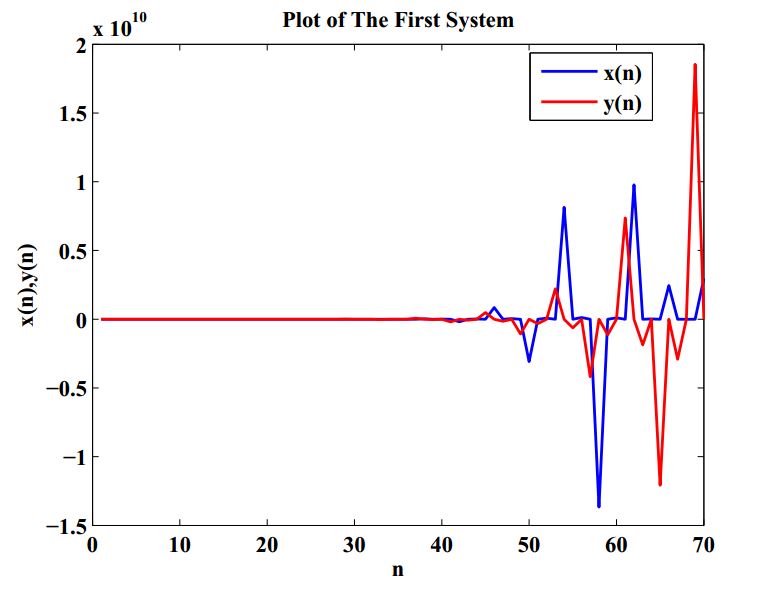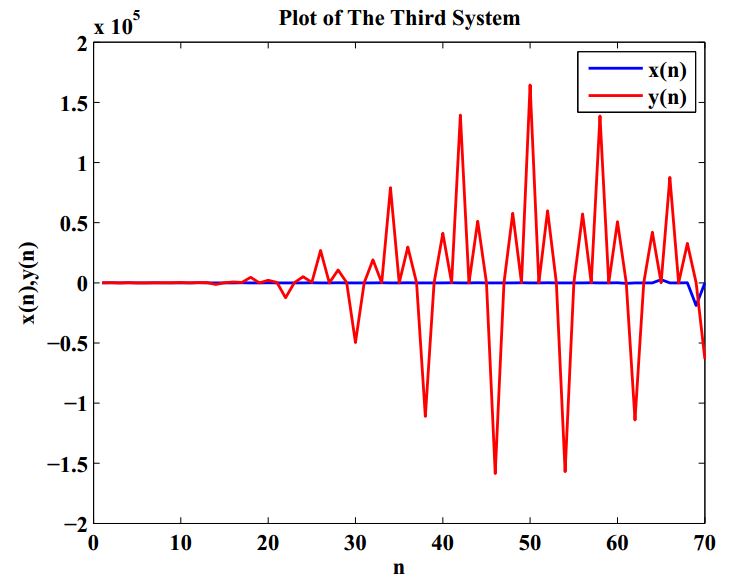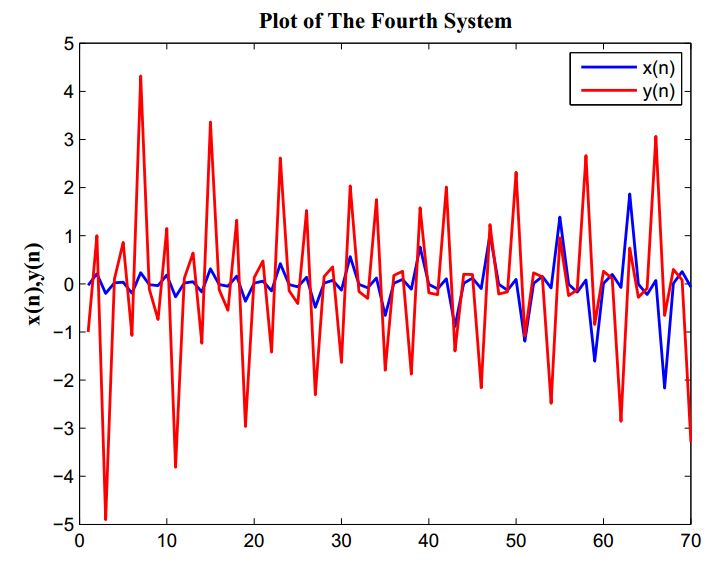It is a well-known fact that the majority of rational difference equations cannot be solved theoretically. As a result, some scientific experts use manual iterations to obtain the exact solutions of some of these equations. In this paper, we obtain the fractional solutions of the following systems of difference equations:
$$
x_{n+1}=\frac{x_{n-1}y_{n-3}}{y_{n-1}\left( -1-x_{n-1}y_{n-3}\right) },\ \ \
y_{n+1}=\frac{y_{n-1}x_{n-3}}{x_{n-1}\left( \pm 1\pm y_{n-1}x_{n-3}\right) }
,\ \ \ n=0,1,…,
$$
where the initial data \(x_{-3},\ x_{-2},\ x_{-1},\ \)\ \(
x_{0},\ y_{-3},\ y_{-2},\ y_{-1}\) and \(\ \ y_{0}\;\) are arbitrary non-zero real numbers. All solutions will be depicted under specific initial conditions.
Theorem Let \(\left\{ x_{n},y_{n}\right\} \) be a solution to system (1) and let \(x_{-3}=a,\ x_{-2}=b,\ x_{-1}=c,\ x_{0}=d,\ y_{-3}=\alpha ,\ y_{-2}=\beta ,\ y_{-1}=\gamma \) and \(y_{0}=\omega .\) Then, for \(n=0,\ 1,\ \ldots\), we have \begin{eqnarray*} x_{4n-3} &=&\frac{\left( -1\right) ^{n}c^{n}\alpha ^{n}\underset{i=0}{ \overset{n-1}{\Pi }}\left[ \left( 2i\right) a\gamma +1\right] }{ a^{n-1}\gamma ^{n}\left( c\alpha +1\right) ^{n}},\ \ \ x_{4n-2}=\frac{\left( -1\right) ^{n}d^{n}\beta ^{n}\underset{i=0}{\overset{n-1}{\Pi }}\left[ \left( 2i\right) b\omega +1\right] }{b^{n-1}\omega ^{n}\left( d\beta +1\right) ^{n}}, \\ x_{4n-1} &=&\frac{c^{n+1}\alpha ^{n}\underset{i=0}{\overset{n-1}{\Pi }}\left[ \left( 2i+1\right) a\gamma +1\right] }{a^{n}\gamma ^{n}},\ \ \ x_{4n}=\frac{ d^{n+1}\beta ^{n}\underset{i=0}{\overset{n-1}{\Pi }}\left[ \left( 2i+1\right) b\omega +1\right] }{b^{n}\omega ^{n}}, \end{eqnarray*} and \begin{eqnarray*} y_{4n-3} &=&\frac{a^{n}\gamma ^{n}}{c^{n}\alpha ^{n-1}\underset{i=0}{\overset {n-1}{\Pi }}\left[ \left( 2i+1\right) a\gamma +1\right] },\ \ \ y_{4n-2}= \frac{b^{n}\omega ^{n}}{d^{n}\beta ^{n-1}\underset{i=0}{\overset{n-1}{\Pi }} \left[ \left( 2i+1\right) b\omega +1\right] }, \\ y_{4n-1} &=&\frac{\left( -1\right) ^{n}a^{n}\gamma ^{n+1}\left( c\alpha +1\right) ^{n}}{c^{n}\alpha ^{n}\underset{i=0}{\overset{n-1}{\Pi }}\left[ \left( 2i+2\right) a\gamma +1\right] },\ \ \ y_{4n}=\frac{\left( -1\right) ^{n}b^{n}\omega ^{n+1}\left( d\beta +1\right) ^{n}}{d^{n}\beta ^{n}\underset{ i=0}{\overset{n-1}{\Pi }}\left[ \left( 2i+2\right) b\omega +1\right] }. \end{eqnarray*}
Proof. It is easy to see that the results hold for \(n=0\). Next, we assume that \(n>1\) and suppose that the solutions hold for \(n-1.\) That is \begin{eqnarray*} x_{4n-7} &=&\frac{\left( -1\right) ^{n-1}c^{n-1}\alpha ^{n-1}\underset{i=0}{ \overset{n-2}{\Pi }}\left[ \left( 2i\right) a\gamma +1\right] }{ a^{n-2}\gamma ^{n-1}\left( c\alpha +1\right) ^{n-1}},\ \ \ x_{4n-6}=\frac{ \left( -1\right) ^{n-1}d^{n-1}\beta ^{n-1}\underset{i=0}{\overset{n-2}{\Pi }} \left[ \left( 2i\right) b\omega +1\right] }{b^{n-2}\omega ^{n-1}\left( d\beta +1\right) ^{n-1}}, \\ x_{4n-5} &=&\frac{c^{n}\alpha ^{n-1}\underset{i=0}{\overset{n-2}{\Pi }}\left[ \left( 2i+1\right) a\gamma +1\right] }{a^{n-1}\gamma ^{n-1}},\ \ \ x_{4n-4}= \frac{d^{n}\beta ^{n-1}\underset{i=0}{\overset{n-2}{\Pi }}\left[ \left( 2i+1\right) b\omega +1\right] }{b^{n-1}\omega ^{n-1}} \end{eqnarray*} and \begin{eqnarray*} y_{4n-7} &=&\frac{a^{n-1}\gamma ^{n-1}}{c^{n-1}\alpha ^{n-2}\underset{i=0}{ \overset{n-2}{\Pi }}\left[ \left( 2i+1\right) a\gamma +1\right] },\ \ \ y_{4n-6}=\frac{b^{n-1}\omega ^{n-1}}{d^{n-1}\beta ^{n-2}\underset{i=0}{ \overset{n-2}{\Pi }}\left[ \left( 2i+1\right) b\omega +1\right] }, \\ y_{4n-5} &=&\frac{\left( -1\right) ^{n-1}a^{n-1}\gamma ^{n}\left( c\alpha +1\right) ^{n-1}}{c^{n-1}\alpha ^{n-1}\underset{i=0}{\overset{n-2}{\Pi }} \left[ \left( 2i+2\right) a\gamma +1\right] },\ \ \ y_{4n-4}=\frac{\left( -1\right) ^{n-1}b^{n-1}\omega ^{n}\left( d\beta +1\right) ^{n-1}}{ d^{n-1}\beta ^{n-1}\underset{i=0}{\overset{n-2}{\Pi }}\left[ \left( 2i+2\right) b\omega +1\right] }. \end{eqnarray*} Following this, system (1) gives us \begin{eqnarray*} x_{4n-3} &=&\frac{x_{4n-5}y_{4n-7}}{y_{4n-5}\left( -1-x_{4n-5}y_{4n-7}\right) } \\ &=&\frac{\frac{c^{n}\alpha ^{n-1}\underset{i=0}{\overset{n-2}{\Pi }}\left[ \left( 2i+1\right) a\gamma +1\right] }{a^{n-1}\gamma ^{n-1}}\frac{ a^{n-1}\gamma ^{n-1}}{c^{n-1}\alpha ^{n-2}\underset{i=0}{\overset{n-2}{\Pi }} \left[ \left( 2i+1\right) a\gamma +1\right] }}{\frac{\left( -1\right) ^{n-1}a^{n-1}\gamma ^{n}\left( c\alpha +1\right) ^{n-1}}{c^{n-1}\alpha ^{n-1} \underset{i=0}{\overset{n-2}{\Pi }}\left[ \left( 2i+2\right) a\gamma +1 \right] }\left[ -1-\frac{c^{n}\alpha ^{n-1}\underset{i=0}{\overset{n-2}{\Pi } }\left[ \left( 2i+1\right) a\gamma +1\right] }{a^{n-1}\gamma ^{n-1}}\frac{ a^{n-1}\gamma ^{n-1}}{c^{n-1}\alpha ^{n-2}\underset{i=0}{\overset{n-2}{\Pi }} \left[ \left( 2i+1\right) a\gamma +1\right] }\right] } \\ &=&\frac{-\left( -1\right) ^{-n+1}c^{n}\alpha ^{n}\underset{i=0}{\overset{n-2 }{\Pi }}\left[ \left( 2i+2\right) a\gamma +1\right] }{a^{n-1}\gamma ^{n}\left( c\alpha +1\right) ^{n-1}\left[ 1+c\alpha \right] }=\frac{\left( -1\right) ^{n}c^{n}\alpha ^{n}\underset{i=0}{\overset{n-1}{\Pi }}\left[ \left( 2i\right) a\gamma +1\right] }{a^{n-1}\gamma ^{n}\left( c\alpha +1\right) ^{n}}. \end{eqnarray*} Moreover, one can observe from system (1) that \begin{eqnarray*} y_{4n-3} &=&\frac{y_{4n-5}x_{4n-7}}{x_{4n-5}\left[ 1+y_{4n-5}x_{4n-7}\right] } \\ &=&\frac{\frac{\left( -1\right) ^{n-1}a^{n-1}\gamma ^{n}\left( c\alpha +1\right) ^{n-1}}{c^{n-1}\alpha ^{n-1}\underset{i=0}{\overset{n-2}{\Pi }} \left[ \left( 2i+2\right) a\gamma +1\right] }\frac{\left( -1\right) ^{n-1}c^{n-1}\alpha ^{n-1}\underset{i=0}{\overset{n-2}{\Pi }}\left[ \left( 2i\right) a\gamma +1\right] }{a^{n-2}\gamma ^{n-1}\left( c\alpha +1\right) ^{n-1}}}{\frac{c^{n}\alpha ^{n-1}\underset{i=0}{\overset{n-2}{\Pi }}\left[ \left( 2i+1\right) a\gamma +1\right] }{a^{n-1}\gamma ^{n-1}}\left[ 1+\frac{ \left( -1\right) ^{n-1}a^{n-1}\gamma ^{n}\left( c\alpha +1\right) ^{n-1}}{ c^{n-1}\alpha ^{n-1}\underset{i=0}{\overset{n-2}{\Pi }}\left[ \left( 2i+2\right) a\gamma +1\right] }\frac{\left( -1\right) ^{n-1}c^{n-1}\alpha ^{n-1}\underset{i=0}{\overset{n-2}{\Pi }}\left[ \left( 2i\right) a\gamma +1 \right] }{a^{n-2}\gamma ^{n-1}\left( c\alpha +1\right) ^{n-1}}\right] } \end{eqnarray*} \begin{eqnarray*} &=&\frac{\frac{a\gamma \underset{i=0}{\overset{n-2}{\Pi }}\left[ \left( 2i\right) a\gamma +1\right] }{\underset{i=0}{\overset{n-2}{\Pi }}\left[ \left( 2i+2\right) a\gamma +1\right] }}{\frac{c^{n}\alpha ^{n-1}\underset{i=0 }{\overset{n-2}{\Pi }}\left[ \left( 2i+1\right) a\gamma +1\right] }{ a^{n-1}\gamma ^{n-1}}\left[ 1+\frac{a\gamma \underset{i=0}{\overset{n-2}{\Pi }}\left[ \left( 2i\right) a\gamma +1\right] }{\underset{i=0}{\overset{n-2}{ \Pi }}\left[ \left( 2i+2\right) a\gamma +1\right] }\right] } \\ &=&\frac{a\gamma \underset{i=0}{\overset{n-2}{\Pi }}\left[ \left( 2i\right) a\gamma +1\right] a^{n-1}\gamma ^{n-1}}{c^{n}\alpha ^{n-1}\underset{i=0}{ \overset{n-2}{\Pi }}\left[ \left( 2i+1\right) a\gamma +1\right] \left[ \underset{i=0}{\overset{n-2}{\Pi }}\left[ \left( 2i+2\right) a\gamma +1 \right] +a\gamma \underset{i=0}{\overset{n-2}{\Pi }}\left[ \left( 2i\right) a\gamma +1\right] \right] } \\ &=&\frac{a^{n}\gamma ^{n}}{c^{n}\alpha ^{n-1}\underset{i=0}{\overset{n-1}{ \Pi }}\left[ \left( 2i+1\right) a\gamma +1\right] }. \end{eqnarray*} Similarly, other results can be proved. The proof has been completed.
Theorem 2. Let \(\left\{ x_{n},y_{n}\right\} \) be a solution to system (2) and assume that \(x_{-3}=a,\ x_{-2}=b,\ x_{-1}=c,\ x_{0}=d,\ y_{-3}=\alpha ,\ y_{-2}=\beta ,\ y_{-1}=\gamma \) and \(y_{0}=\omega .\) Then, for \(n=0,\ 1,\ …\) we have \begin{eqnarray*} x_{4n-3} &=&\frac{\left( -1\right) ^{n}c^{n}\alpha ^{n}}{a^{n-1}\gamma ^{n}\left( c\alpha +1\right) ^{n}},\ \ \ x_{4n-2}=\frac{\left( -1\right) ^{n}d^{n}\beta ^{n}}{b^{n-1}\omega ^{n}\left( d\beta +1\right) ^{n}}, \\ x_{4n-1} &=&\frac{\left( -1\right) ^{n}c^{n+1}\alpha ^{n}\left( a\gamma +1\right) ^{n}}{a^{n}\gamma ^{n}},\ \ \ x_{4n}=\frac{\left( -1\right) ^{n}d^{n+1}\beta ^{n}\left( b\omega +1\right) ^{n}}{b^{n}\omega ^{n}} \end{eqnarray*} and \begin{eqnarray*} y_{4n-3} &=&\frac{\left( -1\right) ^{n}a^{n}\gamma ^{n}}{c^{n}\alpha ^{n-1}\left( a\gamma +1\right) ^{n}},\ \ \ y_{4n-2}=\frac{\left( -1\right) ^{n}b^{n}\omega ^{n}}{d^{n}\beta ^{n-1}\left( b\omega +1\right) ^{n}}, \\ y_{4n-1} &=&\frac{\left( -1\right) ^{n}a^{n}\gamma ^{n+1}\left( c\alpha +1\right) ^{n}}{c^{n}\alpha ^{n}},\ \ \ y_{4n}=\frac{\left( -1\right) ^{n}b^{n}\omega ^{n+1}\left( d\beta +1\right) ^{n}}{d^{n}\beta ^{n}}. \end{eqnarray*}
Proof. The solutions are verified for \(n=0\). Next, we let \(n>1\) and assume that the results hold for \(n-1.\) That is \begin{eqnarray*} x_{4n-7} &=&\frac{\left( -1\right) ^{n-1}c^{n-1}\alpha ^{n-1}}{a^{n-2}\gamma ^{n-1}\left( c\alpha +1\right) ^{n-1}},\ \ \ x_{4n-6}=\frac{\left( -1\right) ^{n-1}d^{n-1}\beta ^{n-1}}{b^{n-2}\omega ^{n-1}\left( d\beta +1\right) ^{n-1} }, \\ x_{4n-5} &=&\frac{\left( -1\right) ^{n-1}c^{n}\alpha ^{n-1}\left( a\gamma +1\right) ^{n-1}}{a^{n-1}\gamma ^{n-1}},\ \ \ x_{4n-4}=\frac{\left( -1\right) ^{n-1}d^{n}\beta ^{n-1}\left( b\omega +1\right) ^{n-1}}{ b^{n-1}\omega ^{n-1}} \end{eqnarray*} and \begin{eqnarray*} y_{4n-7} &=&\frac{\left( -1\right) ^{n-1}a^{n-1}\gamma ^{n-1}}{c^{n-1}\alpha ^{n-2}\left( a\gamma +1\right) ^{n-1}},\ \ \ y_{4n-6}=\frac{\left( -1\right) ^{n-1}b^{n-1}\omega ^{n-1}}{d^{n-1}\beta ^{n-2}\left( b\omega +1\right) ^{n-1}}, \\ y_{4n-5} &=&\frac{\left( -1\right) ^{n-1}a^{n-1}\gamma ^{n}\left( c\alpha +1\right) ^{n-1}}{c^{n-1}\alpha ^{n-1}},\ \ \ y_{4n-4}=\frac{\left( -1\right) ^{n-1}b^{n-1}\omega ^{n}\left( d\beta +1\right) ^{n-1}}{ d^{n-1}\beta ^{n-1}}. \end{eqnarray*} Now, the first relation is given by \begin{eqnarray*} x_{4n-3} &=&\frac{x_{4n-5}y_{4n-7}}{y_{4n-5}\left( -1-x_{4n-5}y_{4n-7}\right) } \\ &=&\frac{\frac{\left( -1\right) ^{n-1}c^{n}\alpha ^{n-1}\left( a\gamma +1\right) ^{n-1}}{a^{n-1}\gamma ^{n-1}}\frac{\left( -1\right) ^{n-1}a^{n-1}\gamma ^{n-1}}{c^{n-1}\alpha ^{n-2}\left( a\gamma +1\right) ^{n-1}}}{\frac{\left( -1\right) ^{n-1}a^{n-1}\gamma ^{n}\left( c\alpha +1\right) ^{n-1}}{c^{n-1}\alpha ^{n-1}}\left[ -1-\frac{\left( -1\right) ^{n-1}c^{n}\alpha ^{n-1}\left( a\gamma +1\right) ^{n-1}}{a^{n-1}\gamma ^{n-1} }\frac{\left( -1\right) ^{n-1}a^{n-1}\gamma ^{n-1}}{c^{n-1}\alpha ^{n-2}\left( a\gamma +1\right) ^{n-1}}\right] } \\ &=&\frac{-\left( -1\right) ^{-n+1}c\alpha \ c^{n-1}\alpha ^{n-1}}{ a^{n-1}\gamma ^{n}\left( c\alpha +1\right) ^{n-1}\left[ 1+c\alpha \right] }= \frac{\left( -1\right) ^{n}c^{n}\alpha ^{n}}{a^{n-1}\gamma ^{n}\left( c\alpha +1\right) ^{n}}. \end{eqnarray*} Similarly, system (2) leads \begin{eqnarray*} y_{4n-3} &=&\frac{y_{4n-5}x_{4n-7}}{x_{4n-5}\left( -1-y_{4n-5}x_{4n-7}\right) } \\ &=&\frac{\frac{\left( -1\right) ^{n-1}a^{n-1}\gamma ^{n}\left( c\alpha +1\right) ^{n-1}}{c^{n-1}\alpha ^{n-1}}\frac{\left( -1\right) ^{n-1}c^{n-1}\alpha ^{n-1}}{a^{n-2}\gamma ^{n-1}\left( c\alpha +1\right) ^{n-1}}}{\frac{\left( -1\right) ^{n-1}c^{n}\alpha ^{n-1}\left( a\gamma +1\right) ^{n-1}}{a^{n-1}\gamma ^{n-1}}\left[ -1-\frac{\left( -1\right) ^{n-1}a^{n-1}\gamma ^{n}\left( c\alpha +1\right) ^{n-1}}{c^{n-1}\alpha ^{n-1} }\frac{\left( -1\right) ^{n-1}c^{n-1}\alpha ^{n-1}}{a^{n-2}\gamma ^{n-1}\left( c\alpha +1\right) ^{n-1}}\right] } \\ &=&\frac{-\left( -1\right) ^{-n+1}a\gamma \ a^{n-1}\gamma ^{n-1}}{ c^{n}\alpha ^{n-1}\left( a\gamma +1\right) ^{n-1}\left[ 1+a\gamma \right] }= \frac{\left( -1\right) ^{n}a^{n}\gamma ^{n}}{c^{n}\alpha ^{n-1}\left( a\gamma +1\right) ^{n}}. \end{eqnarray*} Accordingly, the remaining relations of system (2) can be verified. Hence, this achieves the proof.
Theorem 3. Assume that \(\left\{ x_{n},y_{n}\right\} \) is a solution to system (3) and suppose that \(x_{-3}=a,\ x_{-2}=b,\ x_{-1}=c,\ x_{0}=d,\ y_{-3}=\alpha ,\ y_{-2}=\beta ,\ y_{-1}=\gamma \) and \(y_{0}=\omega .\) Then, for \(n=0,\ 1,\ …\) we have \begin{eqnarray*} x_{4n-3} &=&\frac{c^{n}\alpha ^{n}\underset{i=0}{\overset{n-1}{\Pi }}\left[ \left( 2i\right) a\gamma -1\right] }{a^{n-1}\gamma ^{n}\left( c\alpha +1\right) ^{n}},\ \ \ x_{4n-2}=\frac{d^{n}\beta ^{n}\underset{i=0}{\overset{ n-1}{\Pi }}\left[ \left( 2i\right) b\omega -1\right] }{b^{n-1}\omega ^{n}\left( d\beta +1\right) ^{n}}, \\ x_{4n-1} &=&\frac{\left( -1\right) ^{n}c^{n+1}\alpha ^{n}\underset{i=0}{ \overset{n-1}{\Pi }}\left[ \left( 2i+1\right) a\gamma -1\right] }{ a^{n}\gamma ^{n}},\ \ \ x_{4n}=\frac{\left( -1\right) ^{n}d^{n+1}\beta ^{n} \underset{i=0}{\overset{n-1}{\Pi }}\left[ \left( 2i+1\right) b\omega -1 \right] }{b^{n}\omega ^{n}} \end{eqnarray*} and \begin{eqnarray*} y_{4n-3} &=&\frac{\left( -1\right) ^{n}a^{n}\gamma ^{n}}{c^{n}\alpha ^{n-1} \underset{i=0}{\overset{n-1}{\Pi }}\left[ \left( 2i+1\right) a\gamma -1 \right] },\ \ \ y_{4n-2}=\frac{\left( -1\right) ^{n}b^{n}\omega ^{n}}{ d^{n}\beta ^{n-1}\underset{i=0}{\overset{n-1}{\Pi }}\left[ \left( 2i+1\right) b\omega -1\right] }, \\ y_{4n-1} &=&\frac{a^{n}\gamma ^{n+1}\left( c\alpha +1\right) ^{n}}{ c^{n}\alpha ^{n}\underset{i=0}{\overset{n-1}{\Pi }}\left[ \left( 2i+2\right) a\gamma -1\right] },\ \ \ y_{4n}=\frac{b^{n}\omega ^{n+1}\left( d\beta +1\right) ^{n}}{d^{n}\beta ^{n}\underset{i=0}{\overset{n-1}{\Pi }}\left[ \left( 2i+2\right) b\omega -1\right] }. \end{eqnarray*}
Proof. The solutions hold for \(n=0\). Now, we suppose that \(n>1\) and assume that the solutions hold for \(n-1.\) That is \begin{eqnarray*} x_{4n-7} &=&\frac{c^{n-1}\alpha ^{n-1}\underset{i=0}{\overset{n-2}{\Pi }} \left[ \left( 2i\right) a\gamma -1\right] }{a^{n-2}\gamma ^{n-1}\left( c\alpha +1\right) ^{n-1}},\ \ \ x_{4n-6}=\frac{d^{n-1}\beta ^{n-1}\underset{ i=0}{\overset{n-2}{\Pi }}\left[ \left( 2i\right) b\omega -1\right] }{ b^{n-2}\omega ^{n-1}\left( d\beta +1\right) ^{n-1}}, \end{eqnarray*} \begin{eqnarray*} x_{4n-5} &=&\frac{\left( -1\right) ^{n-1}c^{n}\alpha ^{n-1}\underset{i=0}{ \overset{n-2}{\Pi }}\left[ \left( 2i+1\right) a\gamma -1\right] }{ a^{n-1}\gamma ^{n-1}},\ \ \ x_{4n-4}=\frac{\left( -1\right) ^{n-1}d^{n}\beta ^{n-1}\underset{i=0}{\overset{n-2}{\Pi }}\left[ \left( 2i+1\right) b\omega -1 \right] }{b^{n-1}\omega ^{n-1}} \end{eqnarray*} and \begin{eqnarray*} y_{4n-7} &=&\frac{\left( -1\right) ^{n-1}a^{n-1}\gamma ^{n-1}}{c^{n-1}\alpha ^{n-2}\underset{i=0}{\overset{n-2}{\Pi }}\left[ \left( 2i+1\right) a\gamma -1 \right] },\ \ \ y_{4n-6}=\frac{\left( -1\right) ^{n-1}b^{n-1}\omega ^{n-1}}{ d^{n-1}\beta ^{n-2}\underset{i=0}{\overset{n-2}{\Pi }}\left[ \left( 2i+1\right) b\omega -1\right] }, \\ y_{4n-5} &=&\frac{a^{n-1}\gamma ^{n}\left( c\alpha +1\right) ^{n-1}}{ c^{n-1}\alpha ^{n-1}\underset{i=0}{\overset{n-2}{\Pi }}\left[ \left( 2i+2\right) a\gamma -1\right] },\ \ \ y_{4n-4}=\frac{b^{n-1}\omega ^{n}\left( d\beta +1\right) ^{n-1}}{d^{n-1}\beta ^{n-1}\underset{i=0}{ \overset{n-2}{\Pi }}\left[ \left( 2i+2\right) b\omega -1\right] }. \end{eqnarray*} Next, it can be simply seen from system (3) that \begin{eqnarray*} x_{4n-3} &=&\frac{x_{4n-5}y_{4n-7}}{y_{4n-5}\left( -1-x_{4n-5}y_{4n-7}\right) } \\ &=&\frac{\frac{\left( -1\right) ^{n-1}c^{n}\alpha ^{n-1}\underset{i=0}{ \overset{n-2}{\Pi }}\left[ \left( 2i+1\right) a\gamma -1\right] }{ a^{n-1}\gamma ^{n-1}}\frac{\left( -1\right) ^{n-1}a^{n-1}\gamma ^{n-1}}{ c^{n-1}\alpha ^{n-2}\underset{i=0}{\overset{n-2}{\Pi }}\left[ \left( 2i+1\right) a\gamma -1\right] }}{\frac{a^{n-1}\gamma ^{n}\left( c\alpha +1\right) ^{n-1}}{c^{n-1}\alpha ^{n-1}\underset{i=0}{\overset{n-2}{\Pi }} \left[ \left( 2i+2\right) a\gamma -1\right] }\left[ -1-\frac{\left( -1\right) ^{n-1}c^{n}\alpha ^{n-1}\underset{i=0}{\overset{n-2}{\Pi }}\left[ \left( 2i+1\right) a\gamma -1\right] }{a^{n-1}\gamma ^{n-1}}\frac{\left( -1\right) ^{n-1}a^{n-1}\gamma ^{n-1}}{c^{n-1}\alpha ^{n-2}\underset{i=0}{ \overset{n-2}{\Pi }}\left[ \left( 2i+1\right) a\gamma -1\right] }\right] } \\ &=&-\frac{c\alpha \ c^{n-1}\alpha ^{n-1}\underset{i=0}{\overset{n-2}{\Pi }} \left[ \left( 2i+2\right) a\gamma -1\right] }{a^{n-1}\gamma ^{n}\left( c\alpha +1\right) ^{n-1}\left[ 1+c\alpha \right] }=\frac{c^{n}\alpha ^{n} \underset{i=0}{\overset{n-1}{\Pi }}\left[ \left( 2i\right) a\gamma -1\right] }{a^{n-1}\gamma ^{n}\left( c\alpha +1\right) ^{n}}. \end{eqnarray*} Furthermore, system (3) gives that \begin{eqnarray*} y_{4n-3} &=&\frac{y_{4n-5}x_{4n-7}}{x_{4n-5}\left( 1-y_{4n-5}x_{4n-7}\right) } \\ &=&\frac{\frac{a^{n-1}\gamma ^{n}\left( c\alpha +1\right) ^{n-1}}{ c^{n-1}\alpha ^{n-1}\underset{i=0}{\overset{n-2}{\Pi }}\left[ \left( 2i+2\right) a\gamma -1\right] }\frac{c^{n-1}\alpha ^{n-1}\underset{i=0}{ \overset{n-2}{\Pi }}\left[ \left( 2i\right) a\gamma -1\right] }{ a^{n-2}\gamma ^{n-1}\left( c\alpha +1\right) ^{n-1}}}{\frac{\left( -1\right) ^{n-1}c^{n}\alpha ^{n-1}\underset{i=0}{\overset{n-2}{\Pi }}\left[ \left( 2i+1\right) a\gamma -1\right] }{a^{n-1}\gamma ^{n-1}}\left[ 1-\frac{ a^{n-1}\gamma ^{n}\left( c\alpha +1\right) ^{n-1}}{c^{n-1}\alpha ^{n-1} \underset{i=0}{\overset{n-2}{\Pi }}\left[ \left( 2i+2\right) a\gamma -1 \right] }\frac{c^{n-1}\alpha ^{n-1}\underset{i=0}{\overset{n-2}{\Pi }}\left[ \left( 2i\right) a\gamma -1\right] }{a^{n-2}\gamma ^{n-1}\left( c\alpha +1\right) ^{n-1}}\right] } \\ &=&\frac{\frac{a\gamma \underset{i=0}{\overset{n-2}{\Pi }}\left[ \left( 2i\right) a\gamma -1\right] }{\underset{i=0}{\overset{n-2}{\Pi }}\left[ \left( 2i+2\right) a\gamma -1\right] }}{\frac{\left( -1\right) ^{n-1}c^{n}\alpha ^{n-1}\underset{i=0}{\overset{n-2}{\Pi }}\left[ \left( 2i+1\right) a\gamma -1\right] }{a^{n-1}\gamma ^{n-1}}\left[ 1-\frac{a\gamma \underset{i=0}{\overset{n-2}{\Pi }}\left[ \left( 2i\right) a\gamma -1\right] }{\underset{i=0}{\overset{n-2}{\Pi }}\left[ \left( 2i+2\right) a\gamma -1 \right] }\right] } \\ &=&\frac{\left( -1\right) ^{-n+1}a^{n}\gamma ^{n}\underset{i=0}{\overset{n-2} {\Pi }}\left[ \left( 2i\right) a\gamma -1\right] }{c^{n}\alpha ^{n-1} \underset{i=0}{\overset{n-2}{\Pi }}\left[ \left( 2i+1\right) a\gamma -1 \right] \left[ \underset{i=0}{\overset{n-2}{\Pi }}\left[ \left( 2i+2\right) a\gamma -1\right] -a\gamma \underset{i=0}{\overset{n-2}{\Pi }}\left[ \left( 2i\right) a\gamma -1\right] \right] } \\ &=&\frac{\left( -1\right) ^{n}a^{n}\gamma ^{n}}{c^{n}\alpha ^{n-1}\underset{ i=0}{\overset{n-1}{\Pi }}\left[ \left( 2i+1\right) a\gamma -1\right] }. \end{eqnarray*} The remaining formulas can be shown in a similar way.
Theorem 4. Assume that \(\left\{ x_{n},y_{n}\right\} \) is a solution to system (4) and let \(x_{-3}=a,\ x_{-2}=b,\ x_{-1}=c,\ x_{0}=d,\ y_{-3}=\alpha ,\ y_{-2}=\beta ,\ y_{-1}=\gamma \) and \(y_{0}=\omega .\) Then, for \(n=0,\ 1,\ … \) we have \begin{eqnarray*} x_{4n-3} &=&\frac{\left( -1\right) ^{n}c^{n}\alpha ^{n}}{a^{n-1}\gamma ^{n}\left( c\alpha +1\right) ^{n}},\ \ \ x_{4n-2}=\frac{\left( -1\right) ^{n}d^{n}\beta ^{n}}{b^{n-1}\omega ^{n}\left( d\beta +1\right) ^{n}}, \\ x_{4n-1} &=&\frac{c^{n+1}\alpha ^{n}\left( a\gamma -1\right) ^{n}}{ a^{n}\gamma ^{n}},\ \ \ x_{4n}=\frac{d^{n+1}\beta ^{n}\left( b\omega -1\right) ^{n}}{b^{n}\omega ^{n}} \end{eqnarray*} and \begin{eqnarray*} y_{4n-3} &=&\frac{a^{n}\gamma ^{n}}{c^{n}\alpha ^{n-1}\left( a\gamma -1\right) ^{n}},\ \ \ y_{4n-2}=\frac{b^{n}\omega ^{n}}{d^{n}\beta ^{n-1}\left( b\omega -1\right) ^{n}}, \\ y_{4n-1} &=&\frac{\left( -1\right) ^{n}a^{n}\gamma ^{n+1}\left( c\alpha +1\right) ^{n}}{c^{n}\alpha ^{n}},\ \ \ y_{4n}=\frac{\left( -1\right) ^{n}b^{n}\omega ^{n+1}\left( d\beta +1\right) ^{n}}{d^{n}\beta ^{n}}. \end{eqnarray*}
Proof. It is clear that the relations hold for \(n=0.\) Now, we suppose that \(n>1\) and assume that the solutions hold for \(n-1.\) That is \begin{eqnarray*} x_{4n-7} &=&\frac{\left( -1\right) ^{n-1}c^{n-1}\alpha ^{n-1}}{a^{n-2}\gamma ^{n-1}\left( c\alpha +1\right) ^{n-1}},\ \ \ x_{4n-6}=\frac{\left( -1\right) ^{n-1}d^{n-1}\beta ^{n-1}}{b^{n-2}\omega ^{n-1}\left( d\beta +1\right) ^{n-1} }, \\ x_{4n-5} &=&\frac{c^{n}\alpha ^{n-1}\left( a\gamma -1\right) ^{n-1}}{ a^{n-1}\gamma ^{n-1}},\ \ \ x_{4n-4}=\frac{d^{n}\beta ^{n-1}\left( b\omega -1\right) ^{n-1}}{b^{n-1}\omega ^{n-1}} \end{eqnarray*} and \begin{eqnarray*} y_{4n-7} &=&\frac{a^{n-1}\gamma ^{n-1}}{c^{n-1}\alpha ^{n-2}\left( a\gamma -1\right) ^{n-1}},\ \ \ y_{4n-6}=\frac{b^{n-1}\omega ^{n-1}}{d^{n-1}\beta ^{n-2}\left( b\omega -1\right) ^{n-1}}, \\ y_{4n-5} &=&\frac{\left( -1\right) ^{n-1}a^{n-1}\gamma ^{n}\left( c\alpha +1\right) ^{n-1}}{c^{n-1}\alpha ^{n-1}},\ \ \ y_{4n-4}=\frac{\left( -1\right) ^{n-1}b^{n-1}\omega ^{n}\left( d\beta +1\right) ^{n-1}}{ d^{n-1}\beta ^{n-1}}. \end{eqnarray*} Now, it can be obviously observed from system (4) that \begin{eqnarray*} x_{4n-3} &=&\frac{x_{4n-5}y_{4n-7}}{y_{4n-5}\left( -1-x_{4n-5}y_{4n-7}\right) } \\ &=&\frac{\frac{c^{n}\alpha ^{n-1}\left( a\gamma -1\right) ^{n-1}}{ a^{n-1}\gamma ^{n-1}}\frac{a^{n-1}\gamma ^{n-1}}{c^{n-1}\alpha ^{n-2}\left( a\gamma -1\right) ^{n-1}}}{\frac{\left( -1\right) ^{n-1}a^{n-1}\gamma ^{n}\left( c\alpha +1\right) ^{n-1}}{c^{n-1}\alpha ^{n-1}}\left[ -1-\frac{ c^{n}\alpha ^{n-1}\left( a\gamma -1\right) ^{n-1}}{a^{n-1}\gamma ^{n-1}} \frac{a^{n-1}\gamma ^{n-1}}{c^{n-1}\alpha ^{n-2}\left( a\gamma -1\right) ^{n-1}}\right] } \\ &=&\frac{\left( -1\right) ^{-n}c^{n}\alpha ^{n}}{a^{n-1}\gamma ^{n}\left( c\alpha +1\right) ^{n-1}\left[ 1+c\alpha \right] }=\frac{\left( -1\right) ^{n}c^{n}\alpha ^{n}}{a^{n-1}\gamma ^{n}\left( c\alpha +1\right) ^{n}}. \end{eqnarray*} Similarly, one can obtain from system (4) that \begin{eqnarray*} y_{4n-3} &=&\frac{y_{4n-5}x_{4n-7}}{x_{4n-5}\left( -1+y_{4n-5}x_{4n-7}\right) } \\ &=&\frac{\frac{\left( -1\right) ^{n-1}a^{n-1}\gamma ^{n}\left( c\alpha +1\right) ^{n-1}}{c^{n-1}\alpha ^{n-1}}\frac{\left( -1\right) ^{n-1}c^{n-1}\alpha ^{n-1}}{a^{n-2}\gamma ^{n-1}\left( c\alpha +1\right) ^{n-1}}}{\frac{c^{n}\alpha ^{n-1}\left( a\gamma -1\right) ^{n-1}}{ a^{n-1}\gamma ^{n-1}}\left[ -1+\frac{\left( -1\right) ^{n-1}a^{n-1}\gamma ^{n}\left( c\alpha +1\right) ^{n-1}}{c^{n-1}\alpha ^{n-1}}\frac{\left( -1\right) ^{n-1}c^{n-1}\alpha ^{n-1}}{a^{n-2}\gamma ^{n-1}\left( c\alpha +1\right) ^{n-1}}\right] } \end{eqnarray*} \begin{eqnarray*} &=&\frac{a^{n}\gamma ^{n}}{c^{n}\alpha ^{n-1}\left( a\gamma -1\right) ^{n-1} \left[ -1+a\gamma \right] }=\frac{a^{n}\gamma ^{n}}{c^{n}\alpha ^{n-1}\left( a\gamma -1\right) ^{n}}. \end{eqnarray*} Other relations can be likewise proved. Therefore, this completes our proof.
Example 1. In this example, we describe the behaviour of the solution of system (1). Our initial data has been taken as follows: \(x_{-3}=0.21,\ x_{-2}=-0.25,\ x_{-1}=-0.032,\ x_{0}=2,\ y_{-3}=1.06,\ y_{-2}=-0.4,\ y_{-1}=-1.55\) and \(\ y_{0}=0.082.\) See Figure 1.

Example 2. This example demonstrates the plot of system (2). The initial values are considered as follows: \( x_{-3}=0.22,\ x_{-2}=-0.25,\ x_{-1}=0.2,\ x_{0}=0.6,\ y_{-3}=1.03,\ y_{-2}=-0.43,\ y_{-1}=1.5\) and \(\ y_{0}=0.8,\) as depicted in Figure 2.

Example 3. Here, we plot the curves of solutions of system (3). Figure 3 presents this behaviour under the following initial values: \(x_{-3}=0.03,\ x_{-2}=-0.2,\ x_{-1}=10,\ x_{0}=-0.05,\ y_{-3}=2,\ y_{-2}=-4.1,\ y_{-1}=1.4\) and \(\ y_{0}=1.03.\)

Example 4. Figure \ref{fig4} illustrates the behaviour of the solution of system (4). The considered initial conditions in this example are given as follows: \(x_{-3}=0.02,\ x_{-2}=-0.2,\ x_{-1}=0.21,\ x_{0}=-0.03,\ y_{-3}=0.1,\ y_{-2}=-4.9,\ y_{-1}=1,\ y_{0}=-1.\)

